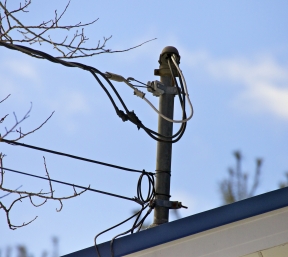Any building or electrical installation must have an electrical service unless it has an onsite power supply or connects via feeder to some other installation that itself has a service.
Requirements and definitions reside in National Electrical Code (NEC) article 230, Services. It defines an electrical service as the part of the installation from the utility point of connection to the first over-current device, usually the main circuit breaker. (Fuses are permitted but have been largely supplanted by circuit breakers.)

The point of connection is defined by the utility. For an aerial service, it is usually a few inches upstream from the weatherhead at a crimp connection. The weatherhead is a waterproof cap on the end of conduit that lets the incoming wires enter without letting in water. It’s shaped like a hood and the wires enter it facing down at an angle of at least 45° to help keep out precipitation. A rubberized gasket seals against the wires. Overhead wires entering the weatherhead are given a drip loop letting rain water that collects drip off before reaching the weatherhead.
The electrician, on behalf of the owner, attaches Type SE cable to the building, bringing it up high enough so that the aerial conductors have the required ground clearance. If this is not possible, a masthead service must be built, raising the point of connection higher than the building.
The individual conductors are separated and routed through holes in the weatherhead, leaving enough free wire for the utility to crimp onto and forming the drip loop. Some utilities do all this work, the customer supplying the materials. An option is to place this segment in conduit, either PVC or metal. Other wiring methods are permitted. NEC Chapter Three, in the individual articles on each type of conductor, contains definitive sections titled Uses Permitted and Uses Not Permitted. These sections provide information on maximum intervals for mounting hardware, minimum bend radii for various cable types, and the like.
The electrician mounts the meter enclosure, usually on the outside wall at a location approved by the utility. The height should be five feet to the center of the meter so that it can easily be read.
An underground service has a different geometry. Its point of connection is the input lugs of the meter socket. That is because the cable from there to the transformer secondary connection is a single unspliced run (unless there is a main disconnect remote from the entrance panel). Obviously, the utility can’t have electricians and homeowners climbing the pole and terminating at a live transformer.
For either an aerial or an underground service, the setup from the meter to the entrance panel is the same. The most efficient arrangement is back-to-back mounting with a short conduit stub permitting the two boxes to be tightly clamped into position, drawn together by locknuts. The piece of conduit, if it is metal, requires additional grounding other than the locknuts scratching through the paint on the enclosures. What is used is a grounding locknut, which has a lug for connection to the grounding electrode conductor.
A prominent feature of service entrance conductors is that unlike most wiring, they do not have over-current protection at the upstream end rated for the wire’s ampacity. For this reason, special design and installation methods are required. These conductors may be in conduit or may be concentric cable (with woven ground on the outside), affording additional protection. Also, splices are prohibited.

David, I like the fact that underground electrical set ups are geometric. Our neighborhood has had a lot of outages lately. I definitely think that we should consider finding a professional that could help us to fix our entire electrical set up.
Thanks for the great tips on how to set up electrical service in buildings and making sure that everything flows perfectly. I am thinking about building a home this winter and so we must think about how we want to do our cabling and how to make everything work optimally. With that being said, I think that we will try to work things underneath the ground and so it looks as clean as possible. Thanks again!
Awesome write-up! I guess I’ll be suggesting the underground cable to the team assigned to our electrical wirings. It seems for organized and clean to look at. Thank you for this article, it is very insightful.
I like your idea of underground set ups. Aside from clean set up, it helps on keeping things organized and I like things that are organized properly. Thanks for this, David!
Hi David thanks for your article, I wish all of our electrical cables were underground in Australia it looks a lot cleaner.
What Code section requires any building or electrical installation to have an electrical service?
I like your idea of electrical service in building. Your blog is so knowledgeable and awesome. Thanks for this, David!
I am installing a meter on an existing house then running service entrance wire to new house where it will attach to the sub panel. What wire to use between the buildings? Can it be use cable? Does it have to be in conduit if I run it under eve of existing house?
Thanks for the great tips on electrical service in buildings. I am thinking about building a home. So we need to cabling. Thanks for sharing this information.